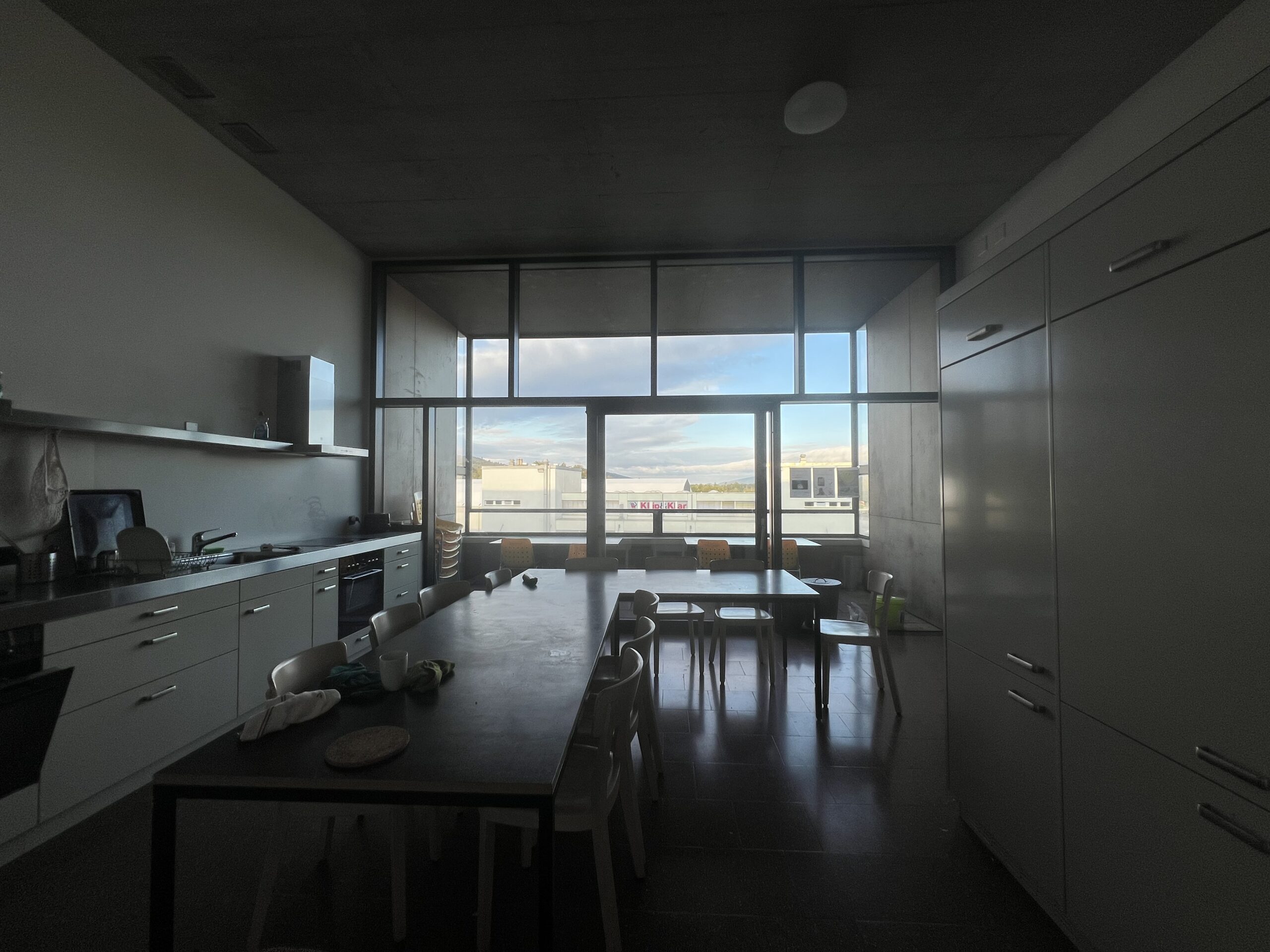The Communal Kitchen

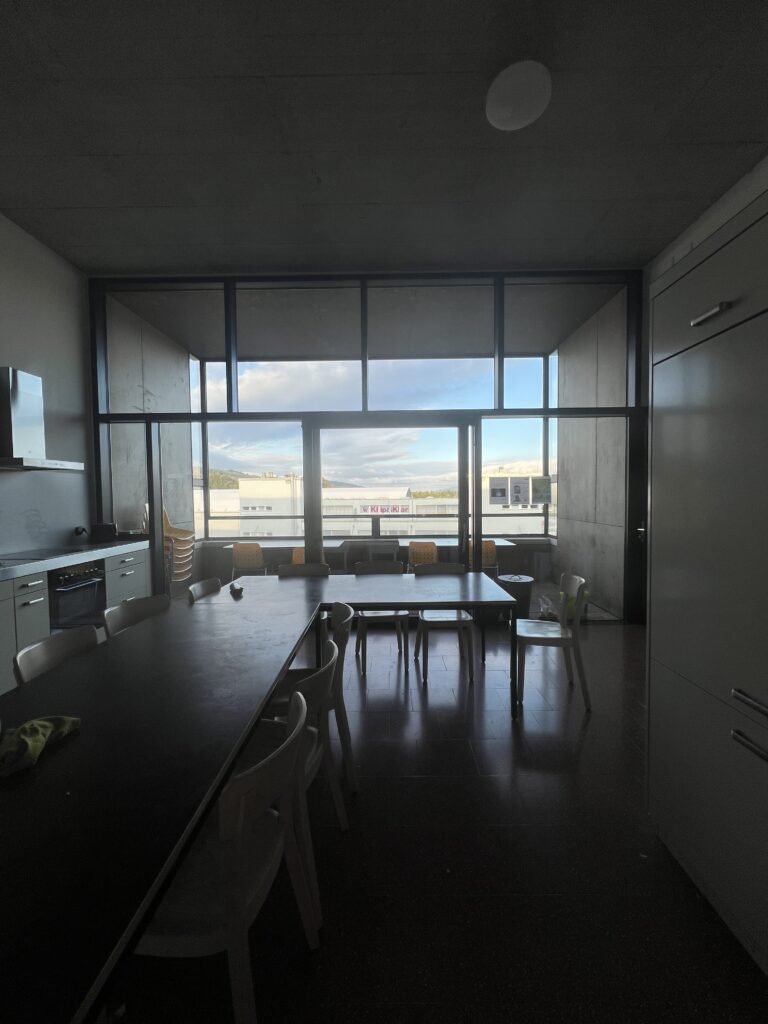
The main purpose of the kitchen is to permit the fifteen residents on the floor to cook. It also serves as a space where the residents eat dinner and socialize with one another.
This space was chosen mainly on account of its atmosphere. It is often filled with residents speaking to one another while they cook and eat. The kitchen fans are often on, further contributing to its loud atmosphere. Sound often seems to disperse throughout the large space and the loud atmosphere. When talking to someone within the atmosphere it seems as if our speech reaches the high ceiling and disperses instead of reaching the person we are talking to.
Throughout the audio recording, many sounds can be heard. These acoustic events include floormates speaking to one another as well as to myself and some floormates cooking dinner. At the time of the recording about 5 or 6 residents were present in the space. The background noise present throughout the recording stems from the kitchen hoods.
The space is large with a high ceiling. The refrigerators act as a portion between the kitchen and the stairs leading up the bedrooms. The kitchen houses two large tables. In terms of sound, there does not seem to be any absorption of sound as it reverberates throughout the space.
The space feels very lively not only in atmosphere but also live in sound. It also feels acoustically muddy as one cannot always make out the words spoken to them. It is also quite reverb-y and cavernous.
Distances from Recorder:
- -0.5 meters
- -1 meter
- -2 meters
- 0.5 meters
- 1 meter
- 2 meters
My Room
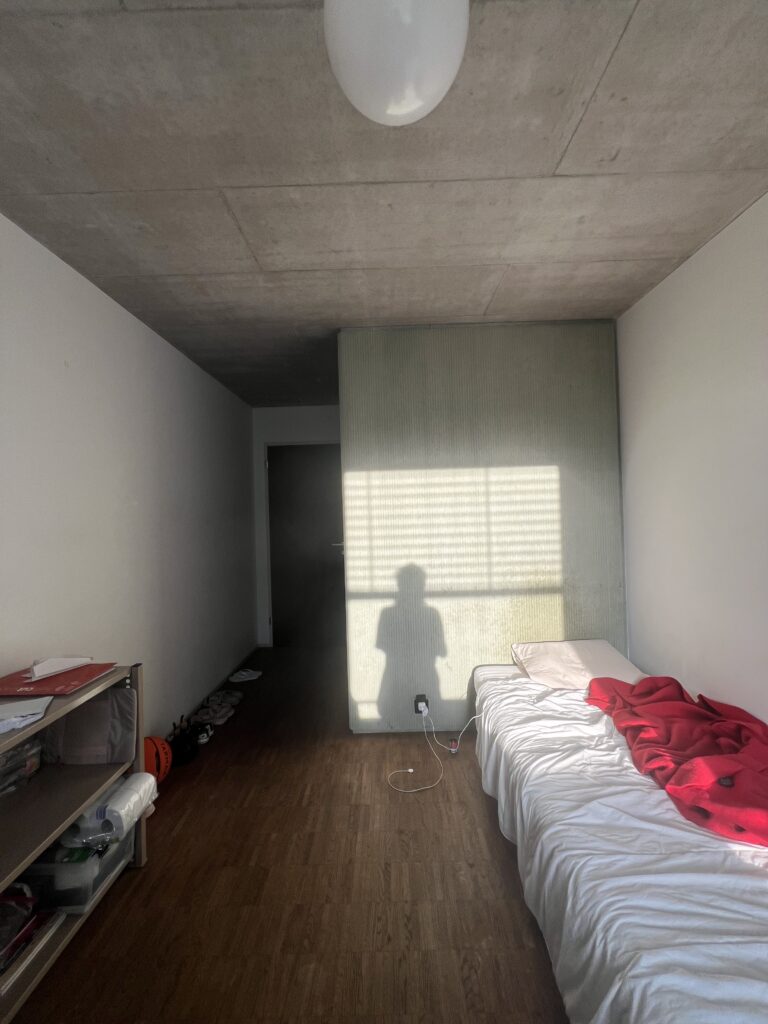
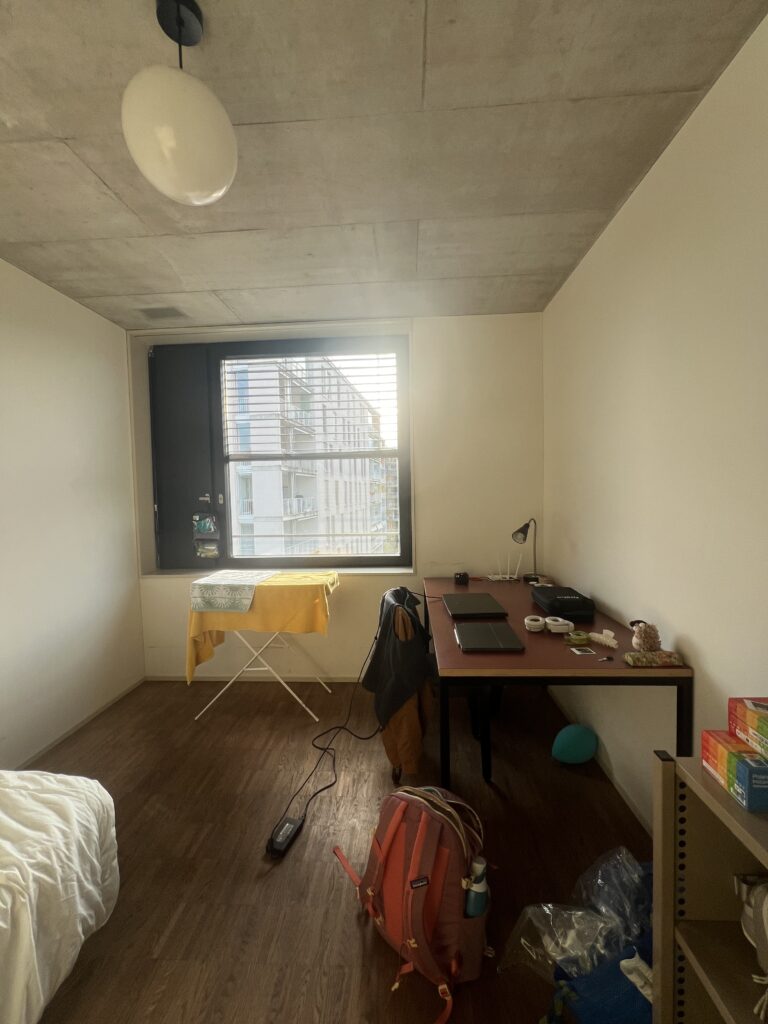
The purpose of my room, as is true with the other rooms on the floor, is to provide residents with their own private space. Additionally, it is where I sleep and where I sometimes choose to study.
This space was chosen due to my accessibility to it and my familiarity with it. Acoustically, the space is of interest on account of its boxy and dead nature. Throughout the recording you can hear how my voice is contained and once I speak, the sound almost immediately dies out, there is no echo or reverb. It feels as if my voice is contained and almost trapped within a box.
The room itself is a rectangular prism with the inclusion of a somewhat large walk-in closet. The closet has little acoustic impact. The overall space is quite empty.
Throughout the audio you can hear my voice in addition to my shuffling around the room. I am unsure what the steady stream of background noise originates from.
My room is spacious yet it lacks the reverb-y and cavernous qualities of the communal kitchen.
Distances from Recorder:
- -0.5 meters
- -1 meter
- 2 meters
- 0.5 meters
- 1 meter
- 2 meters
2 Exploring the Emotional Impact of Everyday Sounds
On my journey to explore the emotional impact of everyday sounds, I ventured into the courtyard behind the building I inhabit as well as the laundry room of my building. Both sites had their unique sounds with a majority of man-made sounds.
I first went to the courtyard. It is an open space filled with grass and a handful of hammocks and swings. The courtyard is surrounded by four residential buildings including my own. Upon exiting the courtyard one will find themselves heading toward a street. The courtyard had numerous sounds. These included cars and buses passing by, although only occasionally as at least two buses have their last bus stop next to my building. I recalled my high school physics class and learning about the Doppler effect as I heard various vehicles moving up and down the road. I heard students chatting in the distance as well as family members speaking to one another in their apartments. These apartments are located in the buildings surrounding the courtyard. I heard the sound of gravel being stepped on as pressure was placed on numerous small rocks as a middle-aged man walked his two dogs. I heard someone cough in the distance and I heard an airplane in the distance. Some form of rumbling was present in the sky but I am unsure whether it was a naturally-occurring sound associated with the weather or if the rumbling stemmed from an airplane. I heard the squeaking of a swing as I made use of the swings in the courtyard.
The courtyard evoked a sense of calmness. Visually, it was quite dark, yet being outside alone in almost pitch darkness was not frightening. Acoustically, the space had an onslaught of white noise. It was calm and still and quiet as I swung up and down. I felt at ease as my mind was cleared. All the thoughts in my head simmered down as I took in the night sky alongside the sounds of residential life.
Loud sounds such as the person coughing initially disrupted this peaceful environment but such sounds then became white noise once the coughing became “common knowledge” and “routine”. The loud rumbling of certain motors would keep me alerted but they were rare. Most vehicles and the motors that helped them run produced sounds that came and went just as the cars came and went. They were also simply background noise. Such sounds only furthered the calmness and quietness of the space.
I then went back into my building and into the laundry room. The laundry room feels and sounds much more industrial than the quiet and peaceful courtyard. There is a routine associated with the space as wash cycles began and wash cycles ended, as residents came in to load or unload their laundry, as the door to the laundry room opened and closed. The space had numerous sounds. I took notice of the sound associated with the start of a wash cycle as it began at a low pitch and sped up to a continuous high pitch. This sound did not cause me discomfort but it did keep me alert. The beeping of another washer, however, did cause mild discomfort as I was reminded of my morning alarm. Another emergent sound included the draining of water once the spin cycle was complete. None of these sounds were particularly loud yet they were loud enough to encourage residents to speak up when talking to one another.
The laundry room had several brief discussions as various sets of flip flops slid across the room. Plastic IKEA bags were unfolded and packed to the brim with clean clothes only to be over to the drying area where students hung their clothes. The space evoked a feeling of action. Sitting down silently while numerous predetermined steps were taken by fellow residents was quite odd. The sound of the washing machines soon became background noise yet the unpredictable pattern of discussions starting and dissipating caused the space to feel like some sort of assembly line. I felt out of place both visually and acoustically as I sat there surrounded by movement and action. I was also the only individual not in her pajamas. The space provided some sort of feeling of isolation as I viewed the residents washing their clothes from the perspective of an outsider.
3 Empirical and Numerical Estimation of Room Acoustic Properties
My Room

50dB = 21.910 seconds
20dB = 21.310 seconds
RT60 = (21.910 – 21.310) * 2 = (0.6) * 2 = 1.2 seconds
I found the reverb time of the room to be surprisingly long and lively. In my analysis of the room in Assignment 1, I deemed the room to be lacking in reverb-y and cavernous qualities. I believe that was due to my lack of familiarity with the space. Specifically, I am never loud within my room for fear of disturbing my neighbors. I am also alone in my room and often take phone calls outside of my room. This exercise demonstrated the reverb-y qualities of my room.
Estimation of the Reverberation Time
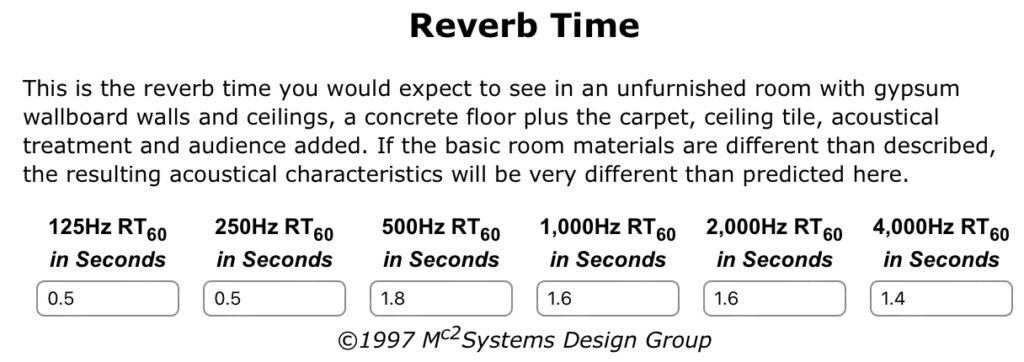
As seen above the estimated reverberation time at 500Hz is 1.8 second and 1.6 seconds at 1000Hz. These estimates should be take with a grain of salt, however, since I cannot guarantee the accuracy of the inputted values. The values I inputted into the calculator were based on my estimation of my room’s dimensions as well as the estimated dimensions of what would be considered a sound absorption surface. For example, I took myself into account. I also took note of the large window which fills a majority of one of the room’s walls.
The Kitchen

At this time I am unsure where I should begin my measurement of the descending slope. I found the acoustics of the kitchen to be fascinating, however, and as such have uploaded the respective graph and audio.

50dB = 34.24 seconds
20dB = 33.06 seconds
RT60 = (34.24 – 33.06) * 2 = (1.18) * 2 = 2.36 seconds
As discussed previously, this room is filled with reverb and is a very “live” room. This exercise confirmed my beliefs and assumptions surrounding the acoustics of the communal kitchen within my dormitory.
Estimation of the Reverberation Time
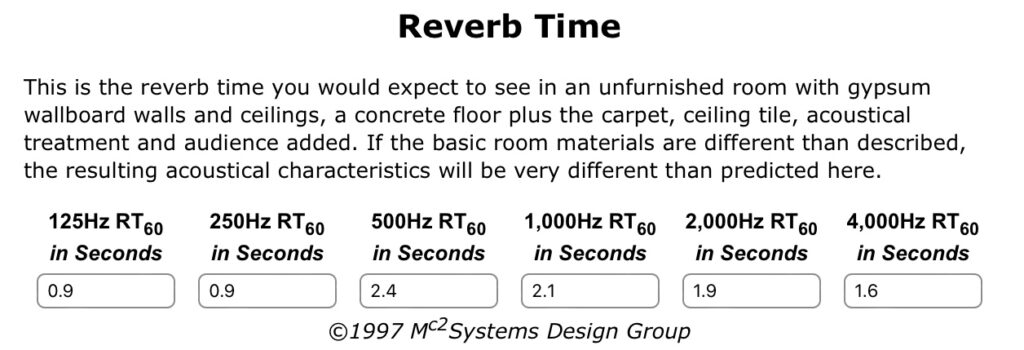
As seen above the estimated reverberation time at 500Hz is 2.4 seconds and 2.1 seconds at 1000Hz. These estimates should be take with a grain of salt, however, since I cannot guarantee the accuracy of the inputted values. The values I inputted into the calculator were based on my estimation of the kitchen’s dimensions as well as the estimated dimensions of what would be considered a sound absorption surface. For example, I took note of the large window which fills the majority of one kitchen wall.
4 Characterization of Room Acoustic Treatments
The Communal Kitchen
Upon reexamination of the space, I found that it severely lacks absorbers and diffusers. The communal kitchen in the building which I inhabit is essentially a large concrete box with plaster walls and a high ceiling. These walls and this ceiling are the main reflectors of the space. While the space does incorporate numerous drawers, closed shelves, and refrigerators, these kitchen essentials also reflect sound. They are either one with the walls or large enough to be considered walls themselves.
The space does have some absorbers. One such absorber are the wooden tables located at the center of the space. As the space is a communal kitchen for a floor with fifteen inhabitants, my floormates and I also act as absorbers of the space. We are, however, not permanent absorbers within the space.
I would argue that there are no acoustic measures within the space as I often cannot hear what someone speaking to me from a foot away is stating. I would suggest incorporating some thick curtains in addition to adding sound-absorbent panels onto the high ceiling of the space. The implementation of such acoustic measures would absorb the excessive sound reflection within the space. Curtains could potentially add a more „home-y“ feel to the space when considering the visual impact of acoustic measures. Ceiling panels would slightly lower the ceiling height. This would maintain the open and spacious aesthetic of the kitchen while effectively absorbing sound waves.
My Room
Similar to the communal kitchen, I find that my room also severely lacks sound proofing. Only minutes prior to writing this text was I told to keep my voice down by the girl who lives in the room below my own.
The room consists of a concrete ceiling and plaster walls. The flooring consists of wood. The ceiling is not high and neither floor nor ceiling or walls are particularly absorbent. They do, however, possess reflective qualities.
My room does possess absorbent surfaces. These include the bed, the desk and the clothing-filled shelves. I myself am also an absorber within the space.
I would once again suggest the implementation of thick curtains to reduce the reflectivity of sound within the space. I would also suggest the implementation of ceiling, wall and floor panels to the space. This would effectively provide at least some control over the excessive traveling of sound in the space.
Aesthetically, I once again believe curtains would provide a more home-like feel to the space. This aesthetic is particularly important in my residence as it is filled with exchange students that do their best to make their rooms as home-like as possible for the short time they inhabit the space. Additionally, instead of making use of non-absorbent window blinds, we can make use of thick, sound-absorbing curtains which may also provide some protection against the cold.
5 The Full Picture
Before the course
The sonic object chosen is a COOP pastry bag which consists of both plastic and paper components. The bag can be found at any nearby COOP’s bakery section. It is used to contain any pastry that a customer chooses to buy. This function relates directly to my chosen space, the communal kitchen on my floor, as it involves food. More specifically, I often buy pretzels at COOP, use the bag to carry the pretzel through the bus ride home, and then I eat the pretzel in the kitchen after lunch or dinner. Once I am done with the pretzel, I crumple up the pastry bag and throw it in the trash bin. In the audio above, you can hear the sound the bag produces as it is crumpled. The bag produces a crisp and brittle ‘crunch’ as it is squished into itself. It is a loud rustle filled with countless “crunches”.
Assembling all the puzzle pieces


Right: View of kitchen facing the interior of the building. Stairs lead to the bedrooms.
The primary function of the communal kitchen is to provide the fifteen residents of the floor with a cooking area. It is thus furnished with cooking essentials such as ovens, stoves, refrigerators, etc. This space also serves as a space where the residents eat dinner and often socialize with one another. It is the largest communal space on the floor and the only one in which we socialize extensively. Other communal spaces consist of the restrooms on the floor.
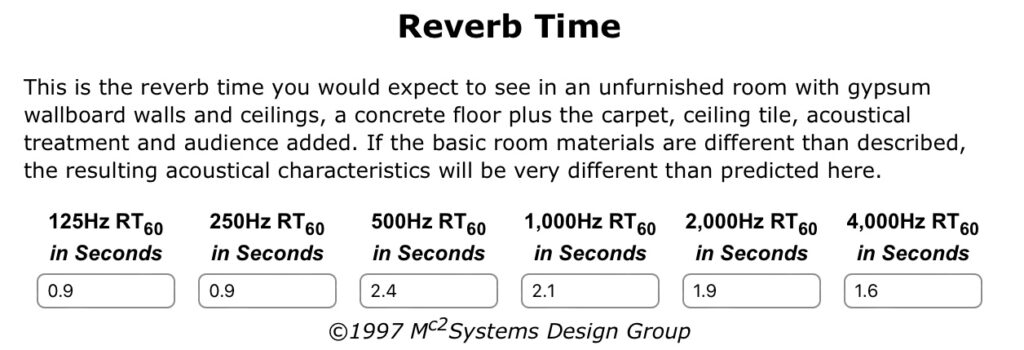
Estimated Reverberation Time: 2.4 seconds at 500Hz
Estimated Volume of the Space: 9m * 7m * 4m = 252m3


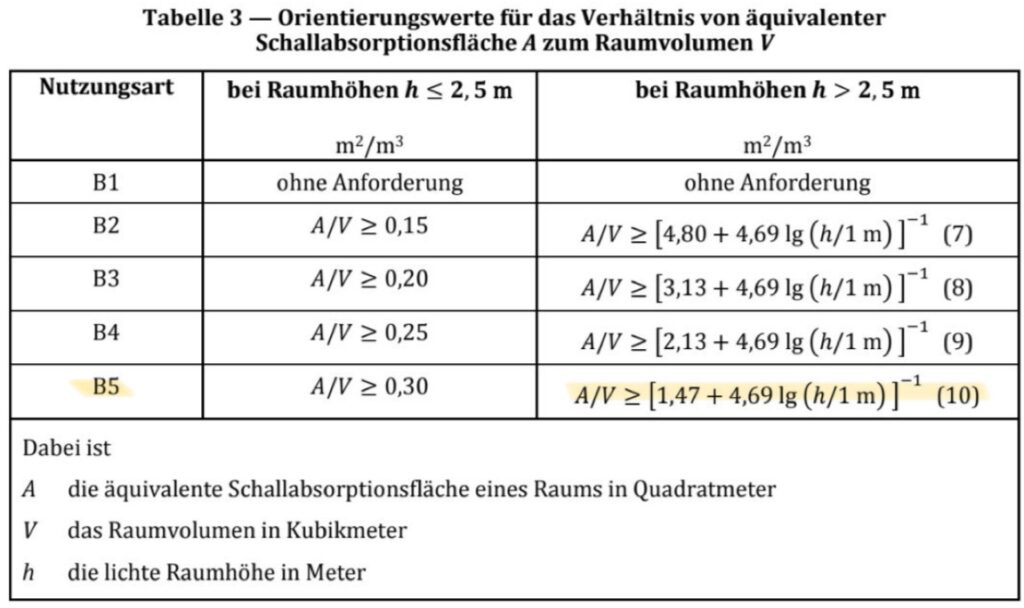
As seen above the current reverberation time is not ideal for a multi-purpose room such as the communal kitchen.
At this time, the room lacks dedicated acoustic absorbers. While one wall consists mainly of glass, the large size of the room, its high ceilings, the extensive use of concrete and the lack of absorbers contribute greatly to its long reverberation time. The room is a large rectangular prism consisting mainly of parallel concrete walls. This geometry and the materials used for the room further contribute to the reflection of sound as opposed to diffusion and absorption.
While the space is a kitchen which often includes people that act as diffusers for the space, we are not enough to significantly and effectively reduce the excessive reverberation in the space. As such certain acoustic measures should be taken. Specifically, the inclusion of absorbers such as thick curtains and absorbent ceiling panels would be ideal for the reduction of reverberation within the space. The implementation of such acoustic measures would absorb the excessive sound reflection within the space while adding a more home-y feel to the aesthetically “bland” space.

